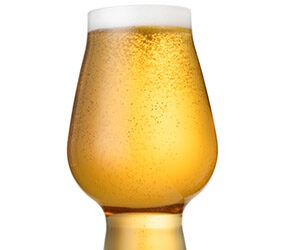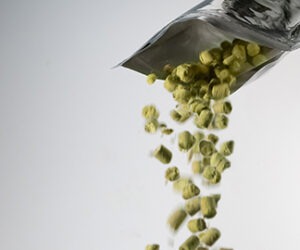Kölsch: Tips from the Pros
Brewers: Tim Etter and Anthony Gibson, Tenaya Creek Restaurant and Brewery in Las Vegas, NV
When we formulated our Tenaya Creek Kölsch, we were definitely going for the traditional style. We toyed around with different variations but always found ourselves coming back to the traditional Kölsch flavor.
For us to brew a traditional Kölsch, the two main areas we focused on were the yeast, including temperature, and the malts. We use an American Ale yeast that we find gives us excellent results for attenuation and a slight fruitiness that rounds out the palate and gives our Kölsch wonderful balance. We also use all German malts to keep with the traditional theme, which include Pils, Munich and wheat malts.
There are lots of ways for both home and commercial brewers to use ingredients and techniques to make a Kölsch stand out. For example, the strain of yeast we use allows us the ability to ferment at a lower temperature to give us a crisp but balanced mouthfeel. It is not a Kölsch strain, but we still achieve the results we want and do not encounter any clarity problems that sometimes come along with Kölsch strains.
An individual brewer’s take on styles can be very different and also what they wish to achieve can also be very different, so it’s tough to give specific advice for making your own Kölsch. In our experience, however, the two most important factors to keep in mind are getting to know the yeast strain you are using and trying to use authentic high quality German malts.
Brewer: Patrick Rowland, Rowland’s Calumet Brewery in Chilton, WI
The recipe for Calumet Kölsch was formulated by my father, and I would consider it to be a classic and true to the original German style.
For the base malt, we use equal parts of wheat, 2-row and 6-row barley malt, plus some Briess Carapils (Chilton is the home of Briess Malt & Ingredients Co.).
At one point, we had a brewer from Germany call the brewery to ask how we made our Kölsch, because in Germany you can’t brew the style and call it Kölsch unless it is from Köln. After we explained to him how we brewed it, and what malt and hops we used, the brewer told us that we had his permission to call it Kölsch — that yes, what we were brewing was the same as the beer of Köln.
Brewing this style most definitely relies on yeast and temperature. What you’re looking for is a yeast with medium flocculation. At the brewery, we actually use a lager yeast that we ferment at ale temperatures.
I would say that Kölsch is really the perfect lawnmower beer, and the late winter is really the best time of year to brew it because of incoming water temperatures, through your heat exhanger are colder.
My advice for homebrewers who want to brew a good Kölsch, based on what we do at the brewery, is to read first about the style. If you want to know what the traditional style is like, try looking in the Classic Beer Style series.
As for brewing techniques, transfer the wort to the fermenter when it is as cold as possible and let the temperature free rise. This process will help the beer develop a crisp, clean taste and brings out a mustiness from the wheat malt.
Brewer: Brock Wagner, Saint Arnold Brewing Company in Houston, TX
Effectively brewing light, delicate beers like Kölsch is so different from making much bigger ales. Our lightest beers took many test brews to perfect the recipes. A good base malt is important because you’re not using any specialty malts and the base malt needs to shine through.
At Saint Arnold, we use a blend of Durst Pils and domestic 2-row for our Fancy Lawnmower. A good hop balance is also important. In ours, we use Hallertau throughout, heavier on the finish. Finally, the yeast is critical. We use White Labs WLP029 (German Ale/Kölsch) yeast, but we run it well below their recommended temperature range. With this method, we still get the fruitiness of the yeast but the end result is a much cleaner, crisper beer.
People forget about yeast for the most part, other than following recipes, and when using the more flavorful Belgian and hefeweizen yeasts. As an experiment, try taking one wort and splitting it into two carboys, pitching each with a different yeast and enjoy the results. With Kölsch and steam-type beers you can play with the yeasts at the extremes of their recommended fermentation temperatures. This is a good way to come up with your own signature beer.
Fancy Lawnmower, like all Saint Arnold beers, wasn’t developed to try to replicate an existing beer. Usually the genesis of our beers comes from enjoying other good beers and then thinking, “how do we improve on these to make something even better?” With Fancy Lawnmower, we really wanted the floral hops to be the focus point of the beer.
If you want to formulate a good Kölsch recipe, first you have to have temperature control for your fermentation. Don’t be afraid of going below the recommended range, but pitch lots of healthy yeast. As a rule of thumb, I tell homebrewers to use at least double what they normally pitch. Make sure the wort is well aerated too. Second, always use a good pale malt — a high quality Pils is best. Finally, choose a hop to showcase and go with it. But don’t be too heavy-handed. This style is supposed to be a delicate, quaffable beer.
This is definitely a beer where bigger is not better. I have yet to see an imperial Kölsch, thank goodness, although I’m sure somebody has tried it. Keep this beer light. It is best when it is a flavorful session beer.



